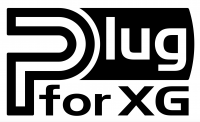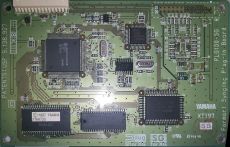XG Plug-in System: Difference between revisions
(Split list of boards and list of hosts into proper sections) |
(Move photo location) |
||
| (6 intermediate revisions by 2 users not shown) | |||
| Line 1: | Line 1: | ||
[[File:XG Plug-in System logo.png|200px|right|thumb|The XG Plug-in System logo.]] | [[File:XG Plug-in System logo.png|200px|right|thumb|The XG Plug-in System logo.]] | ||
The '''XG Plug-in System''' is a system developed by Yamaha for expanding [[Yamaha XG]] tone generators.<ref name=mu100-om-plg>[https://usa.yamaha.com/files/download/other_assets/5/333985/MU100E1.pdf Yamaha MU100 Owner's Manual], pages 163 and 164.</ref> Yamaha produced a series of "plug-in boards" (expansion boards) for this system.<ref name=mu100-om-plg /> Unlike some other expansion board systems (e.g. the [[Roland SR-JV80 series]]), these boards do not just add new sounds, but contain an entire synthesis or effects engine on a board, thus potentially providing more polyphony or additional capabilities to their host device. Korg also produced a similar product in their EXB lineup with the [[EXB-MOSS]] board. | [[File:Modular Synthesis Plug-in System logo.png|400px|right|thumb|The Modular Synthesis Plug-in System logo.]] | ||
The '''XG Plug-in System''', is a system developed by Yamaha for expanding [[Yamaha XG]] tone generators.<ref name=mu100-om-plg>[https://usa.yamaha.com/files/download/other_assets/5/333985/MU100E1.pdf Yamaha MU100 Owner's Manual], pages 163 and 164.</ref> Yamaha produced a series of "plug-in boards" (expansion boards) for this system.<ref name=mu100-om-plg /> Unlike some other expansion board systems (e.g. the [[Roland SR-JV80 series]]), these boards do not just add new sounds, but contain an entire synthesis or effects engine on a board, thus potentially providing more polyphony or additional capabilities to their host device. Korg also produced a similar product in their EXB lineup with the [[EXB-MOSS]] board. | |||
Closely related is Yamaha's '''Modular Synthesis Plug-in System''', which uses the same connectors. Exactly how that differs is unclear; the MU100 and MU128 manuals only cover the XG Plug-in System, whereas the MU1000 manual mentions both, without explaining the difference. | |||
Some of the earlier PLG100 boards include unpopulated [[Waveblaster]] headers, with unused pads for the necessary supporting circuitry, suggesting that the exact implementation of this system was not a certainty at first. | Some of the earlier PLG100 boards include unpopulated [[Waveblaster]] headers, with unused pads for the necessary supporting circuitry, suggesting that the exact implementation of this system was not a certainty at first. | ||
| Line 13: | Line 15: | ||
In total, 12 of the '''Yamaha PLG series''' plug-in boards were produced, these included: | In total, 12 of the '''Yamaha PLG series''' plug-in boards were produced, these included: | ||
[[File:Yamaha_PLG100-SG_front.jpg|230px|right|thumb|PLG100-SG Front.]] | |||
* [[Yamaha PLG100-DX]], is a 16 note polyphonic, six operator FM synthesizer, recreation of the Yamaha DX7.<ref name=mu100-om-plg /> Includes Part EQ, low-pass/high-pass filter and 912 preset voices. | * [[Yamaha PLG100-DX]], is a 16 note polyphonic, six operator FM synthesizer, recreation of the Yamaha DX7.<ref name=mu100-om-plg /> Includes Part EQ, low-pass/high-pass filter and 912 preset voices. | ||
* [[Yamaha PLG100-VL]], is a monophonic virtual acoustic physical modeling synthesizer, using Yamaha's VL-type synthesis. Includes 256 preset voices.<ref name=mu100-om-plg /> | * [[Yamaha PLG100-VL]], is a monophonic virtual acoustic physical modeling synthesizer, using Yamaha's VL-type synthesis. Includes 256 preset voices.<ref name=mu100-om-plg /> | ||
| Line 40: | Line 43: | ||
* [[Yamaha CS6R]] | * [[Yamaha CS6R]] | ||
* [[Yamaha PSR9000 Pro]] | * [[Yamaha PSR9000 Pro]] | ||
* [[Yamaha SW1000XG (sound card) | * [[Yamaha SW1000XG]] (sound card) | ||
* [[Yamaha MOTIF]] | * [[Yamaha MOTIF]] | ||
* [[Yamaha MOTIF Rack]] | * [[Yamaha MOTIF Rack]] | ||
| Line 49: | Line 52: | ||
* [[Kenton Plug Station]] | * [[Kenton Plug Station]] | ||
✽ Comes with the respective AN or DX board pre-installed, not compatible with other PLG boards, or other revisions of those which they are designed to use. | ✽ Comes with the respective AN or DX board pre-installed, not compatible with other PLG boards, or other revisions of those which they are designed to use.<ref>[https://esher.ru/blog/901.html When your PLG150-AN is not working with your AN200 host - vetal strings]</ref> | ||
== References == | == References == | ||
<references /> | <references /> | ||
== External links == | |||
* [https://usa.yamaha.com/files/download/brochure/4/324594/msps_en_02.pdf Yamaha Modular Synthesis Plug-in System brochure] | |||
== See also == | == See also == | ||
* [[Roland VE series]] (similar concept from Roland) | * [[Roland VE series]] (similar concept from Roland) | ||
Latest revision as of 11:18, 29 September 2024


The XG Plug-in System, is a system developed by Yamaha for expanding Yamaha XG tone generators.[1] Yamaha produced a series of "plug-in boards" (expansion boards) for this system.[1] Unlike some other expansion board systems (e.g. the Roland SR-JV80 series), these boards do not just add new sounds, but contain an entire synthesis or effects engine on a board, thus potentially providing more polyphony or additional capabilities to their host device. Korg also produced a similar product in their EXB lineup with the EXB-MOSS board.
Closely related is Yamaha's Modular Synthesis Plug-in System, which uses the same connectors. Exactly how that differs is unclear; the MU100 and MU128 manuals only cover the XG Plug-in System, whereas the MU1000 manual mentions both, without explaining the difference.
Some of the earlier PLG100 boards include unpopulated Waveblaster headers, with unused pads for the necessary supporting circuitry, suggesting that the exact implementation of this system was not a certainty at first.
The PLG100 and PLG150 series board differ in one primary sense: the later 150 series typically include onboard writable memory for user-defined presets, while the earlier 100 series do not. This difference is only relevant for the more studio-oriented host devices, such as the S-series keyboards and MOTIF line, as the MU-series devices offer no facility to write to this memory. There is no issue with PLG150 compatibility for XG devices, they simply cannot utilize this particular aspect of the boards.
The Yamaha MU100 and MU100R are the first modules in the Yamaha MU series to support the system.
Boards
In total, 12 of the Yamaha PLG series plug-in boards were produced, these included:

- Yamaha PLG100-DX, is a 16 note polyphonic, six operator FM synthesizer, recreation of the Yamaha DX7.[1] Includes Part EQ, low-pass/high-pass filter and 912 preset voices.
- Yamaha PLG100-VL, is a monophonic virtual acoustic physical modeling synthesizer, using Yamaha's VL-type synthesis. Includes 256 preset voices.[1]
- Yamaha PLG100-XG, is a 32 note polyphonic XG voice expansion, includes reverb, chorus and insert effects, 480 voice presets and 12 drum kits.
- Yamaha PLG100-VH, is a vocal harmony processor,[1] adding three layers of harmony over of the input. Includes vocoder, detune, chordal and chromatic harmony modes.
- Yamaha PLG100-SG, is a monophonic formant 'synging' vocal synthesizer, with onboard phoneme dictionary and 72 preset voices.[1]
- Yamaha PLG150-DX, is the same as the PLG100-DX, with the addition of 64 user voices.
- Yamaha PLG150-VL, is the same as the PLG100-VL, with the addition of 70 user voices.
- Yamaha PLG150-AN, is a 5 note polyphonic analog modeling synthesizer, using Yamaha's AN-type synthesis. Includes guitar amp sim effect, 3-band EQ, 256 preset and 128 user voices.
- Yamaha PLG150-DR, is a 32 note polyphonic drum expansion, with a wide range of sounds. Includes one reverb effect, 80 preset and 8 user kits.
- Yamaha PLG150-PC, is a 32 note polyphonic latin percussion expansion, sounds from Q UP Arts’ LATIN GROOVE FACTORY library. Includes one reverb effect, 80 preset kits and 8 user kits.
- Yamaha PLG150-PF, is a 64 note polyphonic, PF series Digital Piano expansion. Includes EQ, Reverb, Chorus, and variation effects and 136 preset voices.
- Yamaha PLG100-AP, is a 64 note polyphonic, multi-sampled CFIIIS concert grand piano. Includes EQ, Reverb, Chorus, and variation effects and 64 preset voices.
Supported hosts
- Yamaha MU100
- Yamaha MU100B
- Yamaha MU100R
- Yamaha MU128
- Yamaha MU1000
- Yamaha MU2000
- Yamaha S30
- Yamaha S80
- Yamaha S90
- Yamaha CS6X
- Yamaha CS6R
- Yamaha PSR9000 Pro
- Yamaha SW1000XG (sound card)
- Yamaha MOTIF
- Yamaha MOTIF Rack
- Yamaha MOTIF ES
- Yamaha MOTIF ES Rack
- Yamaha AN200 ✽
- Yamaha DX200 ✽
- Kenton Plug Station
✽ Comes with the respective AN or DX board pre-installed, not compatible with other PLG boards, or other revisions of those which they are designed to use.[2]
References
- ↑ 1.0 1.1 1.2 1.3 1.4 1.5 Yamaha MU100 Owner's Manual, pages 163 and 164.
- ↑ When your PLG150-AN is not working with your AN200 host - vetal strings
External links
See also
- Roland VE series (similar concept from Roland)